15.12 Past Paper Practice
Question 1
Intracytoplasmic sperm injection (ICSI) is a modification of the procedure for in-vitro fertilisation (IVF). A single sperm is injected into an oocyte rather than allowing one of many sperm to fertilise the oocyte.
(a) Suggest one problem that may arise from the use of ICSI. [1]

(b) In preparation for ICSI, infertile women are injected at daily intervals with human follicle stimulating hormone (hFSH) to stimulate the growth and maturation of a number of ovarian follicles. Women may be treated with hFSH extracted from urine (u-hFSH) or with recombinant hFSH (r-hFSH) produced by genetically modified mammalian cells. Each molecule of hFSH consists of two different polypeptide chains, α and β.
The genes for the α and β chains of hFSH, together with their promoters, have been inserted into mammalian ovary cells.
Explain why promoters need to be transferred with desired genes when producing a genetically modified cell. [2]

(c) After treatment with hFSH, oocytes are collected from mature ovarian follicles and examined to check that they have reached metaphase II of meiosis.
Describe how an oocyte in metaphase I of meiosis can be distinguished from one in metaphase II of meiosis. You may use labelled diagrams to illustrate your answer.
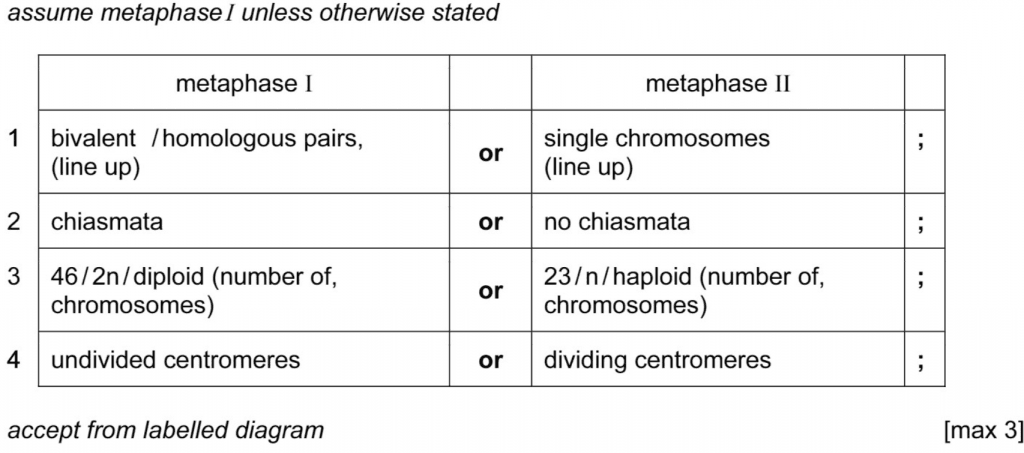
(d) Two groups of women who were being prepared for ICSI were injected at daily intervals with either r-hFSH or with u-hFSH. The results of their treatment are shown in Table 2.1.
| group of women receiving r-hFSH | group of women receiving u-hFSH | |
| umber of women | 63 | 63 |
| total number of oocytes collected | 763 | 407 |
| number of oocytes in metaphase II of meiosis | 634 | 323 |
With reference to Table 2.1, compare the effects of treatment with r-hFSH and u-hFSH and suggest an explanation for any differences. [3]

Whilst the two groups of women described in (d) were being injected at daily intervals with FSH, the concentrations of oestrogen in their blood were measured.
The results are shown in Fig. 2.1.
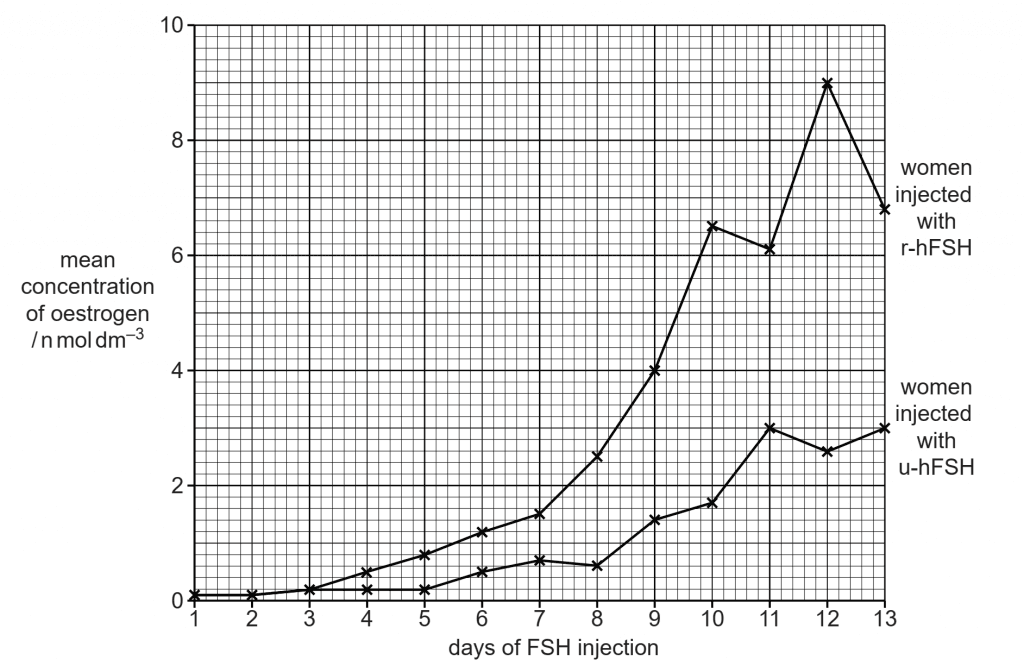
(i) With reference to Fig. 2.1, compare the results for the two groups of women. [3]

(ii) Describe the role of oestrogen in the preparation of these women to receive an embryo. [2]

Question 2
(a) Fig. 5.1 shows a type of neurone found in the brain, called a pyramidal cell.
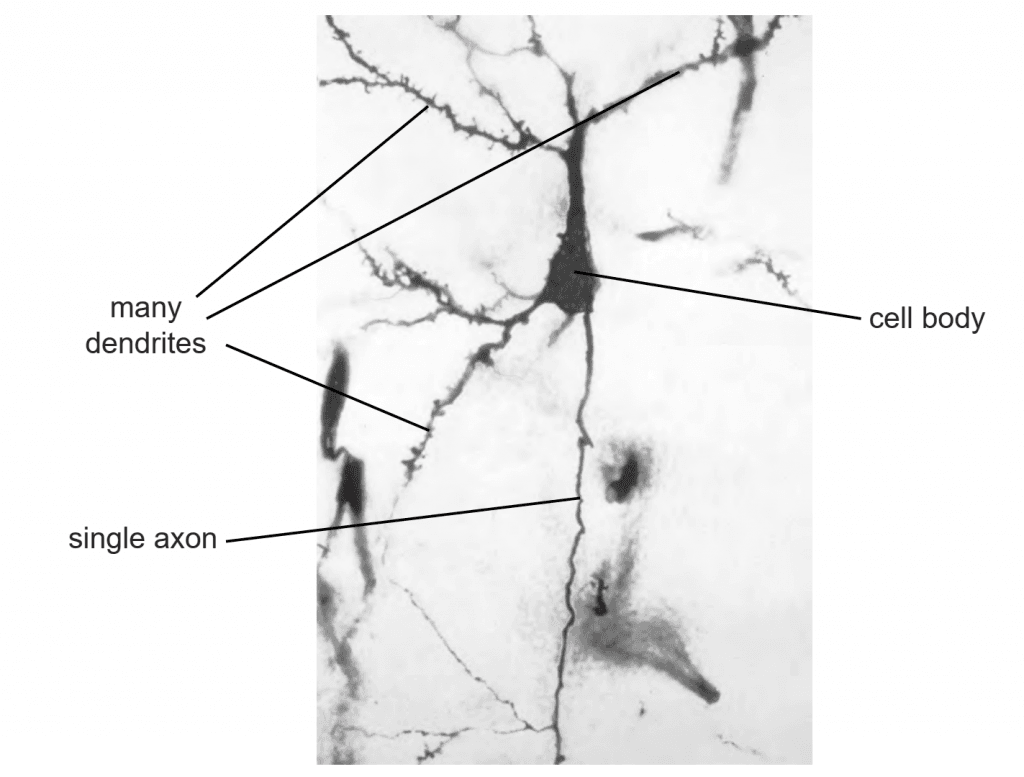
On Fig. 5.1, draw one arrow to indicate the direction in which a nerve impulse will travel, as it leaves the cell body of the pyramidal cell. [1]

(b) Fig. 5.2 shows the percentage of energy used for various processes involved in the maintenance of resting potentials and in the reception and transmission of action potentials by a pyramidal cell.
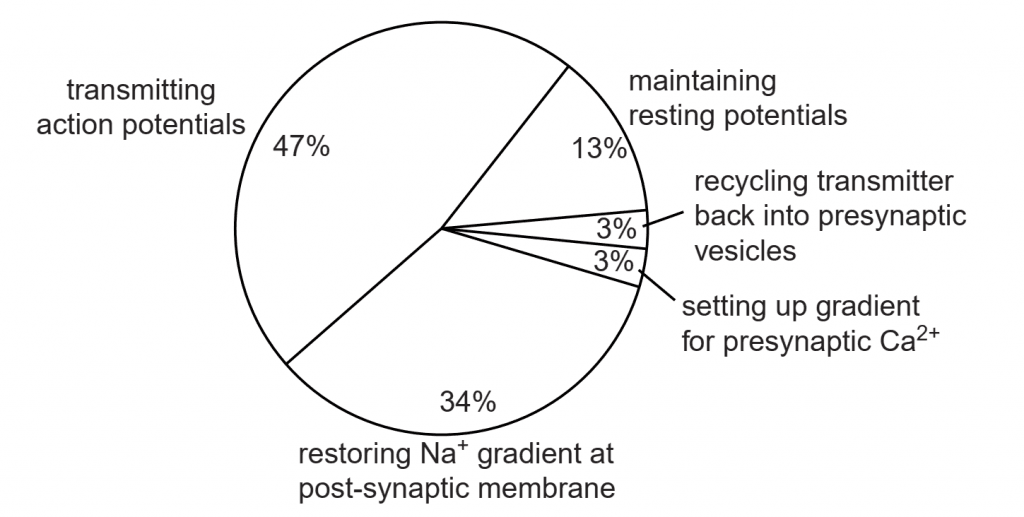
(i) Explain why maintaining a resting potential requires energy. [3]

(ii) Outline the role of calcium ions in passing on an impulse from the pyramidal cell to another neurone. [3]

(iii) Pyramidal cells contain large numbers of mitochondria. There are more mitochondria in each dendrite than in the axon.
With reference to Fig. 5.2, suggest reasons for this distribution of mitochondria. [2]

Question 3
(a) Wheat, Triticum aestivum, owes its origin to hybridisation involving three different, but related, species of grass, A, B and C.
Each of these species had seven pairs of chromosomes (2n = 14).
The hybridisation process is shown in Fig. 3.1.
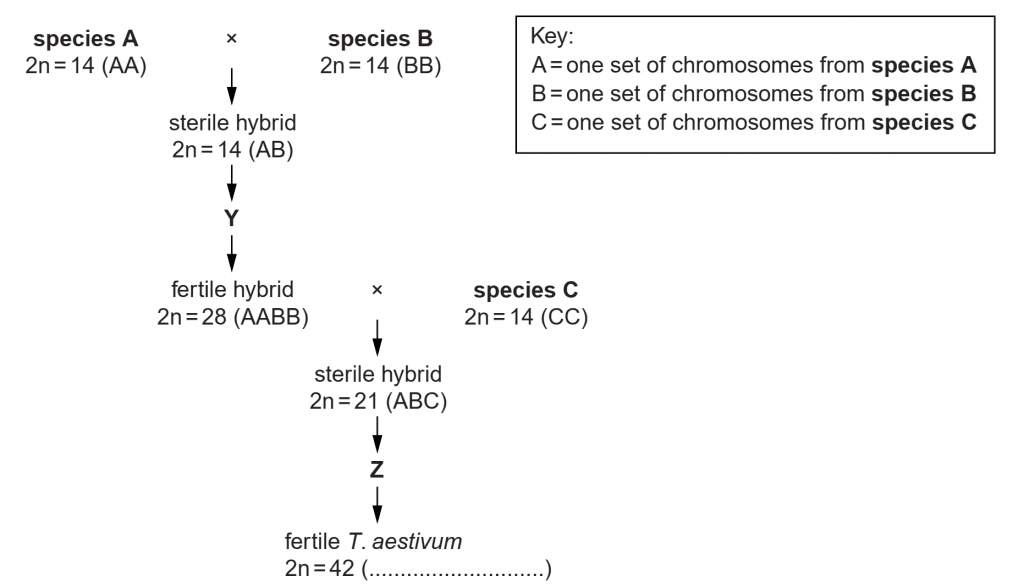
(i) Using the symbols in the key, complete Fig. 3.1 by writing in the chromosome sets of T. aestivum. [1]

(ii) At the points labelled Y and Z in the hybridisation process, a fertile hybrid was produced from a sterile hybrid.
Explain why the hybrid (AB) is sterile and what occurred at the point labelled Y in Fig. 3.1. [4]
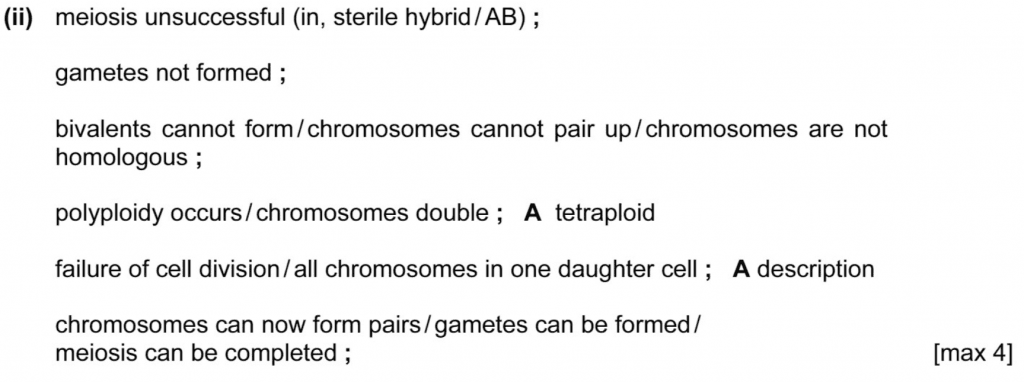
(b) In 2012, permission was granted for a field trial in the UK of genetically modified T. aestivum.
The wheat carries a gene, taken from peppermint plants, that results in the wheat leaves releasing a volatile, non-toxic chemical, (E)-β-farnesene (Eβf), into the atmosphere.
Eβf is not only produced by various species of plants. It is also secreted by aphids when they are disturbed by a predator. Two experiments have been performed into the effect of Eβf on the behaviour of aphids feeding on leaves in closed containers.
Experiment 1
Either 10 cm3 of air from a syringe that contained plant leaves that secrete Eβf
or 10 cm3 of air from a syringe with no such leaves
was added to the containers of feeding aphids.
Experiment 2
Either 20 cm3 of air containing 50ng of Eβf
or 20 cm3 of air containing no Eβf
was added to the containers of feeding aphids.
In both experiments, the number of aphids that stopped feeding and moved away from the food leaves was counted. The results are shown in Table 3.1.
| Experiment 1 | Experiment 1 | Experiment 2 | Experiment 2 | |
| air added to containers of feeding aphids | 10 cm3 air that had been in contact with leaves secreting Eβf | 10 cm3 air that had not been in contact with leaves secreting Eβf | 20 cm3 air containing 50ng Eβf | 20 cm3 air containing no Eβf |
| number of aphids in containers | 99 | 113 | 132 | 106 |
| number of aphids that stopped feeding and moved away from the food leaves | 54 | 1 | 111 | 0 |
(i) Discuss the extent to which the results of these experiments support the idea that Eβf is an alarm signal for aphids. [4]
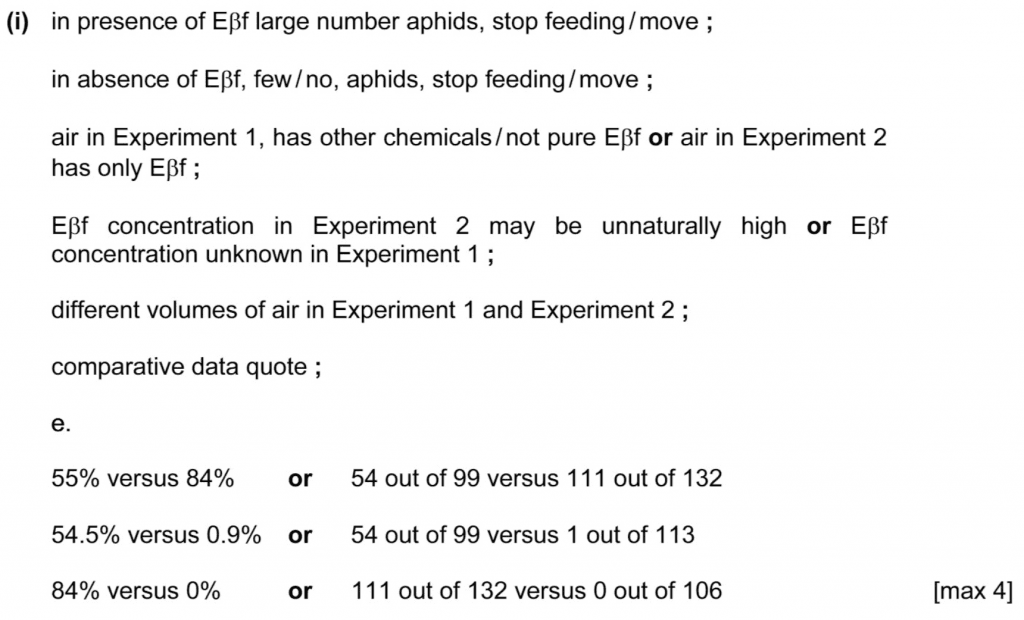
(ii) Other experiments show that Eβf attracts predators of aphids, such as ladybirds. Explain how growing genetically modified wheat secreting Eβf could increase the yield of wheat. [3]

(iii) Suggest why growing this genetically modified wheat might be acceptable to people who object to the growth of genetically modified insect-resistant maize or cotton. [3]

Question 4
(a) The passage below outlines how sensory receptors work. Complete the passage by using the most appropriate scientific term(s).
A sensory receptor cell responds to a stimulus by opening ion ………………………………. in its cell surface membrane. Sodium ions flood into the cell causing the membrane to become ………………………………. . This is called the ………………………………. potential. If this potential is large enough to reach a ………………………………. then an action potential is transmitted to the central nervous system. An increase in the strength of the stimulus will result in an increase in the ………………………………. of action potentials transmitted. [5]
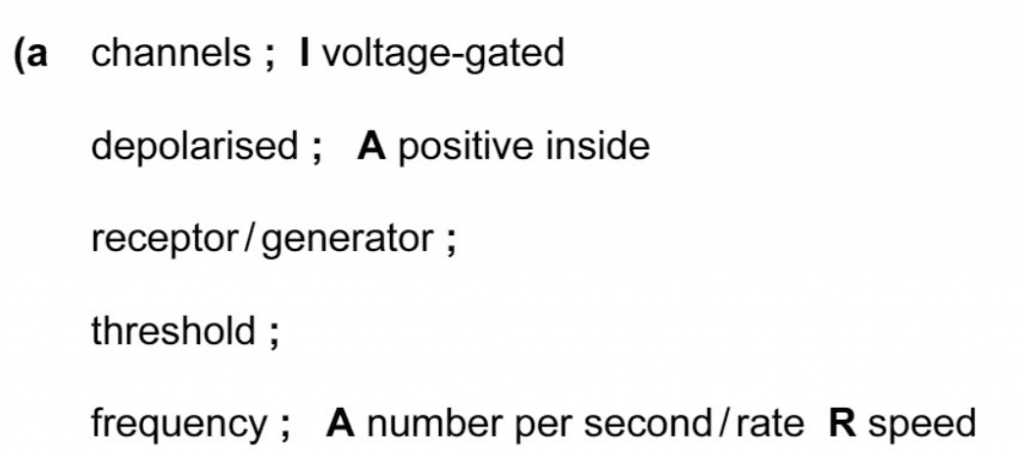
(b) Describe how an action potential is transmitted along a sensory neurone in a mammal. [5]
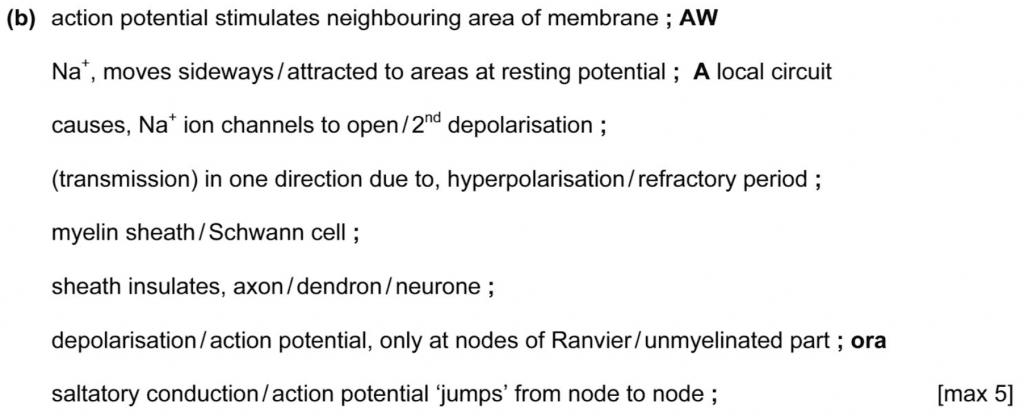
Question 5
Describe how a spinal reflex arc functions and explain why it is an advantage to a mammal. [9]
any eight from
1 sense organ / receptor, detects stimulus ;
2 e.g. light, sound, heat ;
3 idea of very strong stimulus ;
4 action potential generated in sensory neurone ;
5 sensory neurone connects to spinal cord ;
6 synapse with, relay / intermediate, neurone or action potential passes to, relay / intermediate, neurone ;
7 (relay / intermediate / sensory, neurone) synapse with motor neurone or action potential passes to motor neurone ;
8 effector / muscle ;
9 response / described ;
plus
10 fast(er) ;
11 automatic / involuntary / AW ;
12 response always the same / stereotypic ;
13 protects from harm ;
Explain the importance of the myelin sheath in determining the speed of nerve impulses. [6]
any six from
1 (sheath) insulates axon / stops passage of ions ;
2 gaps / nodes of Ranvier ;
3 1–3 mm intervals ;
4 passage of ions can occur (at nodes) ;
5 depolarisation / action potentials, only occur at nodes ;
6 local circuits (between nodes) ;
7 saltatory conduction ;
A description
8 faster (speed of nerve impulse) ;
9 AVP ; e.g. detail of structure of sheath
Question 6
Describe the sliding filament model of muscular contraction. [7]
any seven from:
1 calcium ions released from sarcoplasmic reticulum ;
2 calcium ions bind to troponin ;
3 troponin changes shape and moves tropomyosin ;
4 exposes binding site on actin ;
5 myosin head, binds to site / forms cross bridge ;
6 myosin head tilts ;
7 pulls actin / power stroke ;
8 myosin head, has ATPase / hydrolyses ATP ;
9 myosin head lets go of actin ;
10 myosin head goes back to previous orientation / myosin head re-cocks ;
11 process repeated ;
12 sarcomere shortens ;
Explain the roles of the hormones FSH, LH, oestrogen and progesterone in the human menstrual cycle. [8]
any eight from:
1 FSH secreted by anterior pituitary ;
2 stimulates, development / growth, of follicle (cells in ovary) ;
3 dominant / Graafian, follicle, secretes oestrogen ;
4 oestrogen stimulates repair of endometrium ;
5 oestrogen inhibits further release of FSH ;
6 (large) increase oestrogen, day 14 / midpoint ;
7 stimulates secretion of LH from anterior pituitary ;
8 LH stimulates, ovulation / release of oocyte ;
9 LH stimulates development of corpus luteum ;
10 corpus luteum secretes progesterone ;
11 progesterone continues build-up of endometrium
or
maintains endometrium ;
12 progesterone, inhibits secretion of, LH / FSH ;
13 corpus luteum degenerates so concentration of progesterone falls ;
14 endometrium breaks down ;
Question 7
Describe the ultrastructure of a striated muscle fibre. [8] (s20.41)
any eight from:
1 fibres are multinucleate ;
2 cell surface membrane is sarcolemma ;
3 sarcoplasm has many mitochondria ;
4 sarcoplasmic reticulum membranes have protein pumps ;
5 transverse system tubules / T-system ;
6 ref. to myofibrils ;
7 thick filament / myosin, attached to M line ;
8 thin filament / actin, attached to Z line ;
9 interdigitation of filaments causes striated appearance ;
10 description of one of, A / H / I, bands ;
11 sarcomere is the distance between M lines ;
12 myosin is a fibrous protein with globular protein head ;
13 actin is a chain of globular protein molecules ;
14 tropomyosin / troponin, attached to actin ;
allow marks from an annotated diagram
Explain how auxin causes plant cells to elongate. [7] (s20.41)
any seven from:
1 acid-growth (hypothesis) ;
2 auxin stimulates proton pumps ;
3 (in) cell surface membrane ;
4 protons / H+, pumped into cell wall ;
5 using energy / by active transport ;
6 pH of cell wall decreases / cell wall becomes (more) acidic ;
7 pH-dependent enzymes activated ;
8 ref. to expansins ;
9 bonds between cellulose microfibrils broken ;
10 idea that cell wall, ‘loosens’ / becomes more elastic / able to stretch ;
11 (more) water enters cell / turgor pressure increases ;
12 (so) cell (wall) expands ;
Question 8
Describe and explain how the stimulation of sensory hair cells of a Venus fly trap plant leads to an insect being trapped. [8]
any eight from:
1 mechanical energy converted to electrical ;
2 cell membrane depolarises ;
3 (if at least) two hairs touched (within 35 seconds);
4 action potential occurs ;
5 action potential / depolarisation, spreads over, leaf / lobe ;
6 ref. to hinge / midrib, cells ;
7 H+/ protons, pumped out of cells / pumped into cell walls ;
8 cell wall, loosens / cross-links broken ;
9 calcium pectate dissolves (in middle lamella) ;
10 Ca2+ (ions) enter cells ;
11 water enters by osmosis ;
12 cells, expand / become turgid ;
13 change from convex to concave ;
14 trap shuts, quickly / in <1s / in 0.3s ;
Question 9
(a) In the box below is a list of drugs which affect the nervous system, (i) to (v), and a jumbled list of drug actions, A to E. Select the correct drug activity for each drug by placing the appropriate letter in the relevant box. [5]
| Drug: | Letter: |
| Caffeine (i) | |
| Crack/cocaine (ii) | |
| Nicotine (iii) |
A. Reduces threshold of stimulation of neurones allowing facilitation (easier excitation).
B. Blocks action of acetylcholine at parasympathetic postganglionic nerve endings.
C. Blocks acetylcholine action at neuromuscular junctions.
D. Mimics action of acetylcholine on postsynaptic membranes.
E. Interferes with normal functioning of brain transmitters serotonin and dopamine.
(i) A;
(ii) E;
(iii) D;
(b) The frequency of the heart beat is regulated by the autonomic nervous system and thus can be increased or decreased by the action of certain chemicals and drugs.
(i) What effect does stimulation by the sympathetic nervous system and parasympathetic nervous system have on the frequency of the heart beat? [2]
sympathetic = increase;
parasympathetic = decrease;
(ii) The following table shows the effect of certain substances on the rate of the heart beat. Complete the table by writing ‘increased’ or ‘decreased’ in the appropriate boxes. [5]
| Chemical: | Effect on rate of heart beat: |
| adrenaline | |
| acetylcholine | |
| nicotine |
| Chemical: | Effect on rate of heart beat: |
| adrenaline | increased; |
| acetylcholine | decreased; |
| nicotine | increased; |
Question 10
(a) The table below relates to certain types of receptor found in the body. Complete the empty boxes by writing in one main function for each type of receptor and one main site in the body where each receptor can be found. [8]
| Receptor: | Function: | Site: |
| Proprioceptor | ||
| Thermoreceptor | ||
| Baroreceptor | ||
| Osmoreceptor |
| Receptor: | Function: | Site: |
| Proprioceptor | senses tensions/positions/movements; | in muscles/tendons/joints; |
| Thermoreceptor | senses temperature of blood/body surface; | in hypothalamus/skin; |
| Baroreceptor | senses blood pressure; | in aortic/carotid bodies/ great veins/arches; |
| Osmoreceptor | senses osmotic pressure of blood; | in hypothalamus; |
(b) The graph below shows the number of receptor cells in the human retina along a one millimetre wide belt from the nasal side of the retina to the other side. Distances are in arbitrary units.

(i) Name the two types of receptor A and B and state their main function. [4]
A: rod; scotopic/black and white vision/night vision/vision in dim light;
B: cone; photopic/colour vision/vision in bright light;
(ii) Suggest an explanation for the numbers of receptors found at X and Y.
X: [2]
Y: [2]
X: this is the blind spot;
where there is no room for receptors due to optic nerve fibres leaving the retina at this point;
Y: this is the fovea which is responsible for the best colour vision;
thus only cones present giving great sensitivity;
Question 11
The diagram shows the spinal cord and neurones involved in a simple autonomic reflex arc.

State three ways in which this reflex arc differs from an arc in the voluntary nervous system (such as the
knee jerk reaction). [3]
no relay neurone in autonomic reflex;
visceral ganglion in autonomic reflex;
two motor neurones instead of one (in autonomic reflex);
controls smooth muscle rather than striated muscle/or equivalent;
Question 12
(a) What is a ‘conditioned reflex’ and how may it become established? [4]
a reflex that is initiated not only by the normal unconditioned stimulus but also by a second acquired conditioned
stimulus;
the animal learns to associate the second stimulus with the first and thus responds to both;
for example, Pavlov always rang a bell when he presented food to his dogs;
in time the dogs associated presentation of food with the ringing of the bell;
salivation reflex was then initiated by the bell ringing even if food was withheld;
(b) How do industries sometimes use conditioning when advertising their products? [2]
the sight of the product to be sold is presented with another pleasurable stimulus such as well-loved music or
beautiful scenery;
the potential purchaser then associates the product with pleasure;
(c) Distinguish ‘short term memory’ from ‘long term memory’. [3]
short term memory lasts for only a few minutes but long term memory can last for a life time;
STM is probably present as electrical impulses;
in loops of neurones called ‘reverberating circuits’;
LTM is probably stored chemically in forms of RNA/protein codes in synapses;
Question 13
The diagram of the pupil and iris shows the directions in which the radial and circular muscles of the iris act.

(i) What is the main function of the iris? [1]
to regulate the quantity of light entering the eye/pupil/to prevent dazzling/damage to retina/rods and cones;
(ii) What type of muscle tissue is found in the iris? [1]
smooth/involuntary/visceral muscle;
(iii) What kind of nervous control regulates the iris muscles? [1]
reflex action;
(iv) Complete the following table by writing the most appropriate word or words in the boxes. [3]
| Feature: | Effect of sympathetic stimulation: | Effect of parasympathetic stimulation: |
| radial iris muscles | ||
| circular iris muscles | ||
| pupil size |
| Feature: | Effect of sympathetic stimulation: | Effect of parasympathetic stimulation: |
| radial iris muscles | contraction | no effect/relaxation |
| circular iris muscles | no effect/relaxation | contraction |
| pupil size | dilation/gets larger | constriction/gets smaller |
Question 14
The drawing illustrates a Pacinian corpuscle from the connective tissue layer under the skin. The lamellae to the inside of the connective tissue capsule are spherical sheets of collagen and form vesicles which seal in a lymphlike fluid.

(a) (i) Identify structure A. [1]
nerve ending/sensory neurone/neurone; (not ‘nerve’)
(ii) What is the function of a Pacinian corpuscle? [2]
pressure; receptor;
(iii) Suggest two sites in the body, other than under the skin, where Pacinian corpuscles occur. [2]
Any two of: joints/tendons/muscles/mammary glands/external genitalia;;
(b) (i) Why can the Pacinian corpuscle be described as a transducer? [1]
changes pressure differences into nerve/electrical impulses;
(ii) Suggest how the Pacinian corpuscle works. [2]
pressure distorts the capsule/lamellae;
transmitted by lymph/fluid to nerve endings;
causes depolarisation/sets up an action potential;
Question 15
The diagram shows the structure of the mammalian retina in vertical section to illustrate the position of the light receptors and their associated relay neurones.

(a) (i) Identify the photoreceptors A and B. [1]
A = cone B = rod;
(ii) State two reasons for your identification. [2]
A is conical in shape and B is rod shaped;
a cone synapses to only one relay neurone but several rods synapse to one relay neurone;
(iii) Suggest a function for the melanin-containing epithelium. [1]
to absorb light to prevent internal reflection/dazzling;
(b) (i) How do the sensitivities to light of the photoreceptors A and B differ? [2]
rods (B) are sensitive to dim light but cones (A) are sensitive to bright light only;
rods are sensitive to all wavelengths of visible light but cones are only sensitive to specific wavelengths (of light);
ref to blue, green and red cones;
Question 16
The diagram below shows an eye cut in vertical section.
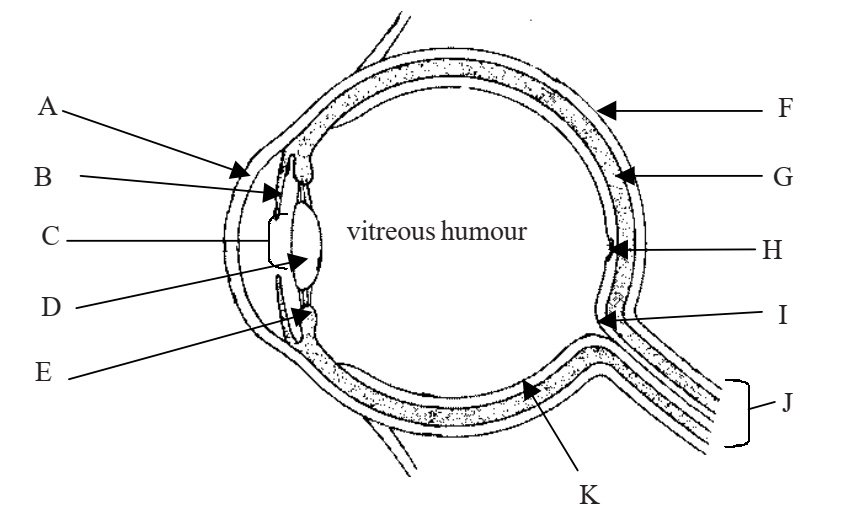
(a) Name structures A to J. [11]
A = cornea; B = iris; C = pupil; D = lens; E = ciliary muscle; F = sclerotic; G = choroid;
H = fovea/yellow spot; I = blind spot; J = optic nerve; K = retina;
(b) Describe how the eye focusses light onto the retina. [5]
refraction by cornea/aqueous humour/vitreous humour forms image on retina;
lens enables fine adjustment to obtain a clear/sharp image;
for near vision ciliary muscles contract thus reducing pull/tension on suspensory ligaments;
elastic lens thus becomes thicker so has more focussing/converging power;
for distant vision ciliary muscles relax thus pulling suspensory ligaments;
(elastic) lens thus pulled to become thinner with less focussing/converging power;
ref to autonomic control of ciliary muscles/sympathetic for distant vision/parasympathetic for near vision;
(c) Describe how the eye regulates the intensity of light reaching the retina. [4]
ref to antagonistic iris muscles regulating diameter of pupil;
in bright light, radial (iris) muscles relax and circular muscles contract;
thus pupil smaller so less light enters;
in dim light, radial muscle contract and circular musles relax;
thus pupil widens and more light enters;
ref to autonomic control/sympathetic stimulates dilation of pupil/parasympathetic stimulates constriction of pupil;
(d) Distinguish between structures H and I. [2]
the fovea/yellow spot is the most sensitive part of the retina/contains a high density of cones for colour vision/does not contain rods;
blind spot does not contain rods or cones/photoreceptors/all room taken up by optic nerve fibres (leaving the retina);
Question 17
The diagram below shows the structure of the human ear.

(a) Name structures D. [1]
A = malleus/hammer; B = incus/anvil; C = stapes/stirrup; D = tympanic membrane/ear drum;
E = fenestra ovalis/oval window; F = fenestra rotunda/round window;
(b) (i) The ear is an example of a transducer. Explain what is meant by this. [2]
transducer changes one form of (signal) energy into another form;
ear changes sound energy/air pressure changes into electrical energy/nerve impulse;
(c) Explain the function of the Eustachian tube. [2]
maintains (balance of) air pressure in middle ear cavity;
by opening to pharynx/throat;
pressure changes caused by movements of ear drum and windows thus compensated for;
Question 18
Describe the fight or flight response. [5]
pupils dilate;
cardiac output raised/heart rate increases/force of beat increases;
arterioles to skin and viscera contract diverting blood to muscles/lungs/heart muscle;
arterioles to heart muscle/lungs/skeletal muscles dilate to enable faster flow of blood;
breathing becomes faster and deeper/bronchioles dilate, improving O2 uptake;
more liver glycogen converted to glucose to supply more energy;
adrenalin release promoted to enhance sympathetic effects;
energy using non-essential muscular movements/secretions of gut are suppressed;
Question 19
(a) Name the parts of the human eye which:
(i) reflect light: [2]
iris; sclerotic;
(ii) refract light: [4]
cornea; aqueous humour; lens; vitreous humour;
(iii) absorb light: [3]
rods; cones; melanin containing retinal epithelium; (allow 1 mark for ‘retina’ unqualified)
(iv) transduce light: [2]
rods; cones;
(b) Name the parts of the human ear which:
(i) gather sound: [1]
pinna; external ear canal;
(ii) transmit sound: [1]
ear drum/tympanic membrane; ossicles/named ossicles; oval window/fenestra ovalis;
Question 20
In the table below state (i) where in a mammal you would expect to find a tendon and ligament, (ii) whether they possess elasticity and (iii) their functions. [6]
| (i)Position: | (ii)Elasticity: | (iii)Function: | |
| Tendon | |||
| Ligament |
| (i)Position: | (ii)Elasticity: | (iii)Function: | ||
| Tendon | link between muscle and bone; | not elastic; | transmit pull of muscle to bone causing movement; | |
| Ligament | link bone to bone (across joint); | is elastic; | prevents dislocation; |
(b) Most joints work according to the principles of levers.
The formula: effort x distance from pivot = load x distance from pivot
can be used to measure the efforts required to move certain loads. The diagram below illustrates the elbow joint and its action in lifting a load.

Suggest why this force does not tear the muscle from the bone. [2]
tendon from muscle is tightly anchored into bone substance;
(collagen) fibres of tendon are continuous with (Sharpey) fibres of bone matrix;
tendon has very high tensile strength;
Question 21
Distinguish between each of the following pairs:
a) Smooth muscle and striated muscle. [2]
smooth muscle made of cells, striated muscle made of sarcomeres/(striated) fibres;
smooth muscle involuntary/autonomically controlled, striated muscle voluntary;
smooth muscle found in viscera, striated muscle attached to skeleton;
Question 22
The diagram below shows the bones and some of the muscles involved in the movement of the elbow joint.

(a) (i) Label the bones A, B, C, and D on the diagram. [4]
(i) A = scapula; B = humerus; C = radius; D = ulna;
(ii) Label the muscles X and Y on the diagram. [2]
X = biceps; Y = triceps;
(iii) What type of joint is the elbow joint? [1]
hinge;
(iv) State the main actions of X and Y. [2]
X contracts to flex the elbow joint;
Y contracts to extend the elbow joint;
(v) Muscles X and Y are said to be ‘antagonistic’. What does this mean? [1]
one muscle moves a bone to a certain position and the other muscle moves it back;
(b)(i) Muscles X and Y can contract either ‘isotonically’ or ‘isometrically’. State the meanings of these terms:
isotonic contraction. [1]
isometric contraction. [1]
isotonic: the tone/tension of the muscle stays the same while the muscle shortens;
isometric: the length of the muscle stays the same while the tone/tension increases;
Question 23
The diagrams below show the appearance of a single sarcomere from a striated muscle fibre during relaxation.
Diagram A shows details that would be visible under a light microscope and Diagram B shows electron microscope detail.

(a) (i) Name the regions labelled 1 to 4 on diagram A. [4]
1 – H line;
2 = isotropic/I disc;
3 = anisotropic/A disc;
4 = Zobie’s/Z line;
(ii) Name the filaments labelled X and Y on diagram B. [2]
X = actin filaments;
Y = myosin filaments;
(iii) Make a sketch of the sarcomere as shown in diagram B as it would appear in the contracted state. [2]

drawing with I discs much narrower;
and H line almost non existent;
(b) Comment on the importances of ATP, calcium ions and creatine phosphate in skeletal muscle contraction.
(i) ATP: [2]
ATP provides energy for the formation of cross bridges between actin and myosin filaments/provides energy for
the change in angle of the cross bridges;
ATP provides energy to pump back calcium ions into sarcoplasmic reticulum/T tubules;
(ii) Calcium ions: [2]
when calcium ions leak from the endoplasmic reticulum/T tubules they displace tropomyosin from the binding
sites allowing cross bridges to form;
when calcium ions are reabsorbed the tropomyosin returns (to cover the binding sites);
(iii) Creatine phosphate: [2]
resting muscle produces too much ATP which cannot be stored (as such);
reacts with creatine to form (energy rich) creatine phosphate which can be stored until a sudden surge of energy is needed;
Question 24
The nervous system coordinates signals around the body via the brain, spinal cord and millions of nerves.
1. An organisms ability to respond to changes in its environment increase its chances of survival.
a) i) What is the difference between receptor and effector cells in terms of stimuli? (2 marks)
Receptor cells – detect stimuli
Effector cells respond to the stimuli
ii) The diagram below shows a simple reflex arc. Identify the different neurons on the diagram below. (3 marks)

A – Sensory neurone
B – Relay neurone
C – Motor neurones
iii) How is an electrical impulse transported across a synapse? (2 marks)
Neurotransmitters
Diffuse
iv) What is the autonomic nervous system and how does it control the body? (3 marks)
– controls the unconscious activities of the body
– speeds up the nervous system via the sympathetic nerves
– slows down the nervous system via the parasympathetic nervous system
b) Photoreceptors are light detecting cells in the eyes of organisms. They convert light into electrical impulses.
i) What part of the eye is most densely populated with ………………………..photoreceptors? (1 mark)
(fovea) retina
ii) Which nerve transmits electrical impulses from the eyes to the brain? (1 mark)
Optic nerve
c) The two types of photoreceptor cell in the eye are rods and cones.
i) Rod cells are more sensitive to light. Explain why this is, in comparison to cone cells. (4 marks)
- Rods can generate action potentials in dim light
- Many rod cells join to one bipolar neurone
- Retinal convergence/ retinal summation
- Cone cells need much brighter light to generate an action potential
- Only one cone cell is connected to each bipolar neurone
ii) What is meant by the term ‘visual acuity’ and how does this differ between rod and cone cells? (3 marks)
- ability to distinguish between points that are close together
- Rods have low visual acuity
- Cones have high visual acuity because each cell is connected to one neurone
2. Organisms have developed many different types of receptors that respond to changes in the environment.
a. i) Identify below what kind of receptor is responding to each type of stimulus. (4 marks)
A. Sensitive to changes in temperature
B. Stimulated by light
C. Sensitive to changes in pressure
D. Stimulated by changes in blood PH
a. Thermoreceptors
b. Photoreceptors
c. Mechanoreceptors/ Pacinian Corpuscle
d. Chemoreceptors
b) For receptor cells to function, they must have membranes that can become ‘excited’.
i) Explain how the resting potential of a neurone is maintained? (3 marks)
- charge is different across the membrane (-65mv/-70mv)
- Sodium/potassium pump
- uses ATP
- pumps 3 Na+ out for 2 K+ in
ii) What happens to the membrane potential when a nerve cell is ………………….stimulated? (2 marks)
- Membrane becomes more permeable
- ions move across the membrane
- Membrane depolarised
iii) What is the precursor to an action potential called? (1 mark)
Generator potential
iv) What is meant by the term threshold stimulus? (1 mark)
the minimum size of stimulus needed to transmit a signal
c) The diagram below shows a receptor cell.

i) What is the name of this receptor? (1 mark)
Pacinian Corpuscle
ii) What changes does it detect in the environment and how does it create an action potential? (4 marks)
- detects changes in mechanical pressure
- pressure deforms the stretch mediated sodium channels
- the movement of sodium ions creates a generator potential — which causes an actual potential
Question 25
The diagram below is of a mammalian nerve cell.

(a) (i) What functional type of neurone is shown in the diagram? [1]
motor;
(ii) Name the parts labelled A to G. [7]
A – dendrite; B = Nissl granules; C = node of Ranvier; D = axon; E = myelin sheath;
F = Schwann cell; G = motor end plate/neuromuscular junction;
(b) State one function of each of the parts labelled A, E and F. [3]
A. receives action potentials from preceding/relay/intermediate/connector neurones;
E. insulates axon causing saltatory conduction;
F. secretes the myelin;
(c) Explain briefly how part G depolarises the muscle fibre. [4]
when action potentials arrive at the synapse they cause calcium ions to leak/enter into the synaptic knobs;
(this) causes release of acetylcholine from the synaptic knobs;
this attaches to receptors on the sarcolemma;
making it permeable to sodium ions;
so that they rush into the fibre causing depolarisation;
Question 26
The diagram below shows the spinal cord of a mammal in transverse section and the neurones involved in a knee jerk reflex action.
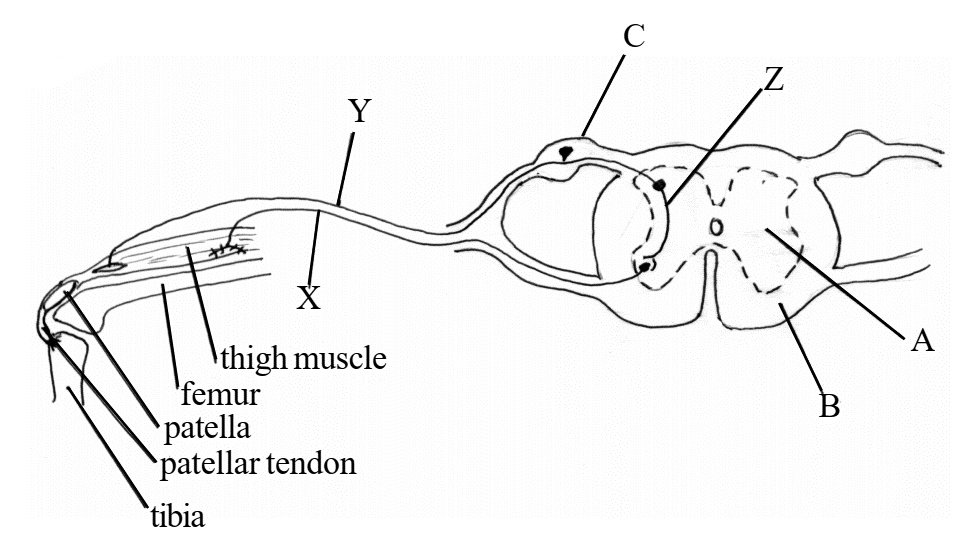
(a) (i) Name the parts labelled A, B and C. [3]
(i) A = grey matter; B = white matter; C.= dorsal root ganglion;
(ii) Distinguish between parts A and B. [2]
A consists of non-myelinated relay neurones running across the spinal cord;
B consists of myelinated relay neurones running up and down the spinal cord;
(b) (i) Name neurone types X, Y and Z and indicate the direction of impulse passage by putting arrows on the neurones in the diagram. [4]
X = motor neurone; Y = sensory neurone; Z = relay neurone;
direction = y to z to x;
(ii) What stimulus would cause a knee jerk reflex to operate? [1]
a tap on the patella tendon/sudden pressure on the patellar tendon/hammer blow or equivalent;
(c) The knee jerk reflex is an example of a spinal reflex since it operates via the spinal cord. Cranial reflexes
operate via the brainstem. Give three examples of cranial reflexes. [3]
Any three of: blinking/pupil reflex/accommodation/ coughing/sneezing/salivation/tear secretion/any other valid example;;;
Question 27
Read through the following passage on neurones and nerve impulses and then fill in the spaces with the most appropriate word or words.
The nervous system contains several types of neurones. ………………………………….. neurones carry impulses to muscles and glands but ………………………………….. neurones carry impulses from receptors to the central nervous system. The interior of a resting nerve fibre has a lower concentration of …………………………………………. ions than its surroundings due to the actions of a ………………………………………….. in its membrane. This leads to a ………………………………………. resting potential on the inside relative to the outside. Depolarisation occurs when the membrane permeability is changed by a ………………………………………… allowing ………………………………….. ions to flood in. If the depolarisation reaches a …………………………………….. value it is propagated along the fibre as an ……………………………………. . In some fibres an insulating layer of ……………………………………. allows the depolarisation to jump between ………………………………………….. making nerve impulse transmission much ………………………………….. .Impulses are propagated across synapses by release of ………………………………….. from vesicles in the synaptic knobs. This release is triggered by an inflow of …………………………………….. ions.
motor; sensory; sodium; sodium pump; negative; stimulus; sodium; threshold; action potential; myelin; nodes;
faster; acetylcholine; calcium;
Question 28
Answer the following questions about the mammalian nervous system.
(a) What is the value of ‘saltatory conduction of nerve impulses’ to the organism? [3]
speeds up the rate of impulse passage in myelinated neurones;
sensory neurones are myelinated thus enabling rapid input of information from receptors to central nervous system;
voluntary motor neurones are myelinated thus allowing rapid response of skeletal muscles;
(c) State two differences between the sympathetic and parasympathetic nervous systems. [2]
sympathetic involves nor-adrenaline as neurotransmitter whereas parasympathetic involves only acetylcholine;
sympathetic tends to increase activities whereas parasympathetic tends to decrease them;
Question 29
All cells in the body have an electrical potential across their cell membranes which is called the ‘resting potential’, which is essential for the cell to be able to perform its functions correctly. Neurones can only develop and transmit nerve impulses if they possess a resting potential to begin with.
(a) With reference to membrane permeabilities, ion pumps, sodium ions and potassium ions, explain how a resting potential is generated. [5]
axon membrane is impermeable to sodium ions but permeable to potassium ions;
sodium pumped out of axon to surrounding tissue fluid;
thus there is a lack of positive ions within the axon which tends to draw potassium ions in;
this inflow of potassium is also supplemented by a weak potassium pump;
however, inflow of potassium ions cannot quite catch up with outflow of sodium ions;
and so inside stays negative with respect to outside;
ATP required to allow pumps to work;
(b) Sensory receptor cells in the body all possess resting potentials. These are developed into nerve impulses which are transmitted to the central nervous system when the stimulus acts on the receptor.
(i) The table below refers to various receptor cells, their position in the body and the stimulus which activates them. Complete the table by filling in the empty boxes.
| Receptor: | Position in body: | Stimulus: |
| bright light | ||
| Pacinian corpuscle | ||
| osmoreceptor | ||
| dim light | ||
| raised blood glucose level | ||
| thermoreceptor |
| Receptor: | Position in body: | Stimulus: |
| cone | retina | bright light |
| Pacinian corpuscle | under the skin | pressure |
| osmoreceptor | hypothalamus | change in blood osmotic pressure |
| rod | retina | dim light |
| beta-cell | islets of Langerhans/pancreas | raised blood glucose level |
| thermoreceptor | hypothalamus | temperature change |
(ii) Receptor cells act as transducers. What is a transducer? [1]
changes one form of energy to another/example;
Question 30
The diagram below shows a recording of an action potential passing along a nerve axon.

(a) (i) What is meant by the term ‘threshold stimulus’? [1]
the smallest stimulus that is capable of setting up an action potential;
(ii) By means of an arrow, indicate on the diagram the probable time when the stimulus was applied. [1]
put arrow on or near to 0.7 millisecond;
(iii) What is the state of the axon membrane from A to B? [1]
at the resting potential;
(b)(i) Describe the changes that are occurring in the axon during the period B to D. [2]
stimulus makes axon membrane become permeable to sodium ions;
these flood into the axon along the diffusion gradient;
thus polarity of membrane reverses to give action potential;
(ii) Describe the changes that are occurring in the axon during the period D to C. [2]
too many positive ions are inside the axon at this stage;
membrane is now super permeable to potassium which floods out of axon along (electrical) gradient;
thus potential across membrane reverses back to resting value, (although correct ionic balance is not yet restored);
(c) Describe how action potentials are propagated along the axon during nerve impulse transmission. [3]
propagated by local currents;
electron flow occurs at margins of depolarised (+) and resting/polarised (-) regions;
these currents make next bit of axon membrane permeable to sodium ions and so region of depolarisation spreads;
Question 31
The diagram below illustrates the structure of a cholinergic synapse between a voluntary motor nerve ending and the sarcolemma of a striated muscle fibre.
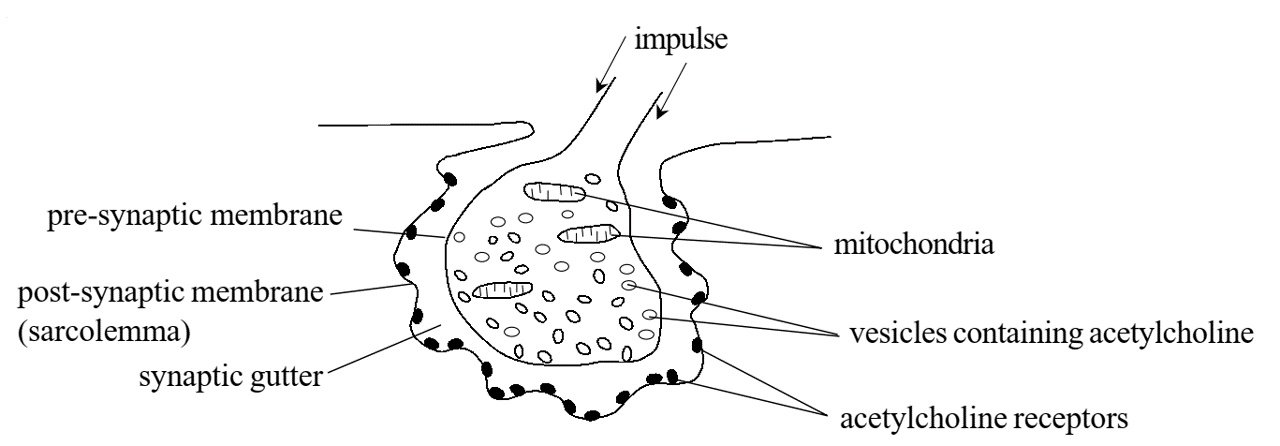
(a) (i) Why do synaptic knobs contain many mitochondria? [2]
provide ATP;
to provide energy for active absorption of acetate/choline into the knobs;
for combining acetate and choline/to make acetylcholine/synthesis of acetylcholine;
(ii) Briefly describe how the arrival of an impulse at the synapse causes depolarisation of the post-synaptic membrane. [5]
calcium ions enter synaptic knobs;
and attract vesicles to the pre-synaptic membrane;
these fuse with the membrane and release acetylcholine;
this attaches to receptors on post synaptic membrane;
making it become permeable to sodium ions;
these rush into the muscle fibre along the concentration gradient;
this alters the potential across the sarcolemma/membrane resulting in an action potential;
(iii) How does the post-synaptic membrane become repolarised? [3]
acetylcholine esterase enzyme is released as soon as the muscle is depolarised;
this removes the acetylcholine from the receptors;
by hydrolysing/splitting it into acetate and choline;
thus membrane of muscle reverts to being impermeable to sodium ions;
resting potential is restored;
(b)(i) How does an adrenergic synapse differ from a cholinergic synapse? [2]
the transmitter substance is nor-adrenaline;
the enzyme which removes it from the receptors is mono-amine oxidase;
(ii) Where are adrenergic synapses found in the body? [1]
in the sympathetic nervous system;
Question 32
Distinguish between each of the following pairs.
(a) A motor neurone and a motor nerve. [3]
motor neurone is a single cell running from CNS to effector organ/muscle/gland;
motor nerve is made of many motor neurones running side by side to either one effector or to several;
contains bundles of neurones grouped together in connective tissue/collagen sheaths;
(b) A myelinated neurone and a non-myelinated neurone. [2]
myelinated neurones conduct impulses quickly/30 – 50 m sec-1, non-myelinated neurones conduct impulses
slowly/5 – l0 m sec-1;
voluntary motor and sensory neurones /white matter relay neurones are myelinated, autonomic motor/grey matter
relay neurones are non-myelinated ;
(c) Rods and cones. [3]
rods are sensitive to dim light, cones to bright light;
rods for black and white vision, cones for colour vision;
rods have poor visual acuity, cones have good visual acuity;
Question 33
Explain each of the following terms.
(a) Refractory period of a neurone. [2]
the period which must elapse after a (first) stimulus before a second stimulus can produce a second action potential;
axon must have repolarised almost completely before another potential can be set up;
(b) Temporal and spatial summation at synapses. [2]
the depolarising effect of discharging synaptic knobs is cumulative (= summation);
in spatial summation several synaptic knobs discharge simultaneously (onto the post-synaptic membrane);
whereas in temporal summation they discharge in rapid succession;
(c) The ‘All or nothing’ law. [2]
if a stimulus is above its threshold value;
it sets up a complete full sized action potential;
larger stimuli do not increase the size of the action potential;
(d) An excitatory synapse. [2]
a synapse which uses acetylcholine or nor-adrenaline as transmitter substances;
to set up an impulse in the post synaptic structure/neurone/muscle;
(e) An inhibitory synapse. [2]
a synapse which uses dopamine/serotonin/glycine as neurotransmitter;
which prevent post-synaptic neurones from being excited by excitatory synapses/act as switch offs;
Question 34
The diagram shows the effect of a stimulus on the membrane potential of a neurone.

Outline the events at each of the stages A-D:
A Resting state: [3]
membrane is impermeable to sodium ions;
sodium ions pumped out by active transport/higher concentration maintained outside;
potassium ions enter along electrical gradient;
influx of potassium cannot catch up with outflux of sodium so membrane is charged;
B Depolarisation: [3]
stimulus causes membrane to become permeable to sodium ions/sodium channels open;
sodium ions flow in;
membrane potential becomes positive;
C Repolarisation: [3]
sodium channels close;
potassium channels open/potassium ions leave the cell;
membrane potential becomes negative;
D Undershoot: [2]
potassium ions continue to leave/potassium channels slow to close;
inside of cell becomes more negative than resting stage;
Question 35
The statements in the table below refer to some effects of auxins and gibberellins in plants. If the statement is correct place a tick (✓) in the appropriate box and if it is incorrect place a cross (✗) in the appropriate box.
| Effect: | Auxins: | Gibberellins: |
| Promote cell enlargement | ||
| Break bud dormancy | ||
| Promote ripening of fruit | ||
| Inhibit lateral growth | ||
| Promote root formation in cuttings | ||
| Promote fruit growth | ||
| Stimulate stomatal opening |
| Effect: | Auxins: | Gibberellins: |
| Promote cell enlargement | ✓ | ✓ |
| Break bud dormancy | ✗ | ✓ |
| Promote ripening of fruit | ✗ | ✗ |
| Inhibit lateral growth | ✓ | ✓ |
| Promote root formation in cuttings | ✗ | ✓ |
| Promote fruit growth | ✓ | ✓ |
| Stimulate stomatal opening | ✗ | ✗ |
Question 36
A coleoptile grown in normal conditions had its tip cut off and replaced with an insert of agar as shown in diagram A. After a few hours the agar was removed and placed asymmetrically on another cut coleoptile as shown in diagram B. The shoots were kept in the dark during the experiment.

(a) (i) In the space above the heading Diagram C draw the coleoptile as you would expect it to appear 12 hours later. [2]
coleoptile bending to left;
taller than in B;
(ii) Explain what is happening in the set up shown in diagram A. [2]
tip is secreting auxin;
diffuses down into the agar gel;
(iii) Explain what is happening in the set up shown in diagram B. [2]
right hand side of coleoptile receives auxin/more auxin than left hand side;
thus cells on right hand side exhibit greater elongation causing bending to left;
(b) How does the plant growth substance involved in this experiment exert its effects? [2]
(auxin) loosens the rigid cellulose framework/cellulose microfibrils of the cell wall;
osmotic uptake of water then enables swelling/elongation;
Question 37
The table below indicates the sites of production and main effects of some plant growth substances. Complete the table by writing appropriate information in the empty boxes.
| Name of growth substance: | Site of production: | One main effect: |
| Ethene | ||
| Promotes leaf fall | ||
| Promotes positive phototropic response | ||
| Stimulates amylase synthesis in germinating seeds | ||
| Stimulates rapid mitosis particularly in embryo |
| Name of growth substance: | Site of production: | One main effect: |
| promotes fruit ripening; | ripening fruits; | |
| leaves/stems/ fruits/seeds; | abscisic acid; | promotes fruit ripening; |
| stem/root tips; | auxin; | |
| embryo/in seeds/buds/ young leaves/root tips; | gibberellin; | |
| fruits/seeds; | cytokinins; |
Question 38
An experiment was performed to investigate the effects of auxin (IAA) and gibberellic acid (GA) on elongation of bean seedlings. Internode sections of the plant/stems were used and kept in identical conditions apart from the following treatments.
The control batch received no growth substance
One batch received IAA only
One batch received GA only
One batch received both IAA and GA
The graph below indicates the results that were obtained

(a) (i) Compare the effects of the three treatments on the elongation of the bean segments. [3]
all caused greater elongation than the control;
GA only had a small increase in (cell) elongation compared with the control group;
IAA only had a much larger effect on stimulating (cell) elongation, especially over the first 30 hours;
IAA + GA had the greatest effect, especially over the first 24 hours/increase over three times greater than in control;
(ii) With reference to the results of this investigation explain the meaning of the term ‘synergism’. [2]
when one substance enhances the effects of another substance;
gibberellic acid enhances the effect of auxin on (cell) elongation/vica versa;
(iii) Suggest a possible source of error in the experiment. [1]
seedlings may not be identical/seedlings may receive slightly different quantities of growth substance/
cutting (the internodes) may interfere with their growth;
(b) Distinguish between the effects of auxins and cytokinins in regulating stem growth. [2]
auxins stimulate cell elongation;
cytokinins stimulate cell division/mitosis;
(c) State two commercial applications of gibberellins. [2]
to encourage fruit setting;
to cause the development of seedless fruits/induce parthenocarpy;
to stimulate amylase production to promote ‘malting’ in the brewing industry;
Question 39
The table below shows the effects of auxin at different concentrations on the growth of shoots and roots of oat seedlings. The elongation of the test seedlings was compared to the elongation of a group of control seedlings which did not receive auxin treatment. A positive value indicates that the test seedlings grew more than the controls and a negative value indicates that the test seedlings grew less than the controls.

a) Plot these results in a suitable graphical form. [5]
axes (auxin on X axis, elongation on Y axis);
suitable scale (at least half of graph paper and easy to use);
accurate plotting;
points joined with ruler (IOB recommendations);
curves labelled/key;
(accept alternative layouts)

b) Compare the response of the shoots to auxin with the response of the roots. [4]
root elongation stimulated most at low auxin concentration/around 10-4ppm;
root elongation inhibited above 10-2ppm/at higher auxin concentrations;
shoot elongation stimulated best at high auxin concentration/1 ppm;
not stimulated at low auxin concentrations/below 10-5ppm;
inhibited at concentrations of 100ppm;
c) Synthetic auxins are used as weedkillers. Suggest how they operate selectively to kill broadleaved weeds such as plantains in a lawn. [3]
(plantains are broad leaved whereas) grasses are narrow leaved;
thus plantains tend to absorb more auxin than grasses and so plantains affected more;
inhibit root growth whilst causing ‘bolting’/overgrowth of shoots which die;
Question 40
Synthetic auxins, such as 2.4-dichlorophenoxyacetic acid (2,4-D) have been used as weedkillers. This is useful because it is a selective herbicide which kills broad-leaved plants but not grasses.
Natural auxin (IAA) is actively transported into cells by a carrier protein molecule in the cell membrane and leaves the cells by facilitated diffusion through a different channel protein molecule. The importing protein will also work for 2,4-D. However the exporting protein cannot transfer 2,4-D back out of the cell.
(a) What are the effects of auxins on root and shoot growth? [3]
cause increased root growth in low concentrations;
stimulate shoot growth in higher concentrations;
inhibit root growth in high concentrations;
low concentrations have no effect on shoot growth/very high concentrations inhibit shoot growth;
(b)(i) Suggest how application of 2,4-D could kill a plant. [3]
could cause inhibition of root growth;
since would accumulate inside the cells;
causes rapid cell elongation so that stems grow too quickly;
but no extra lignified tissue in plant stem;
thus stem collapses/loss of too much water through extra leaves;
(ii) Suggest an explanation for the selective action of 2,4-D. [3]
auxins are absorbed through the plant surface;
broad leaved plants absorb relatively more auxin than narrow leaved plants;
thus broad leaved plants are subjected to a concentration which inhibits root growth/causes shoots to bolt (or eqivalent);
narrow leaved plants are only subjected to a concentration which does not adversely affect root or shoot growth;
(c) Explain how the structures of protein molecules enable channel proteins to be specific in the molecules which they allow through the membrane. [2]
different types of protein have different amino acid sequences;
and thus have different secondary and tertiary structures/3D structures;
and so produce different shaped channels;
Question 41
One of the pairs of characters that Mendel investigated as he worked out the rules of inheritance in pea plants was tall and short. It is now known that tall plants contain an allele, Le, which codes for an enzyme which stimulates the synthesis of gibberellic acid. This allele is dominant to the recessive allele, le, which does not enable the plant to make the enzyme which stimulates the synthesis of gibberellic acid. Plants with the genotypes LeLe and Lele have tall phenotypes, while plants with the genotype lele have short phenotypes.
Other growth substances, such as auxin and cytokinin may be involved in plant growth.
(a) (i) With reference to the plant growth substances involved explain how growth is controlled in the short plants. [3]
auxin secreted by tip of stem;
diffuses down to elongation zone;
causes elongation of cells by modifying their cellulose walls, allowing osmotic expansion;
cytokinin may stimulate apical cell division;
(ii) Explain the greater growth found in the tall plants. [2]
gibberellic acid is produced in presence of Le allele;
acts synergistically with auxin/enhances the effect of auxin thus causing taller growth;
(b) Even though tallness and shortness in pea plants are regulated by a single pair of alleles, considerable variation in height can occur. Why is this so? [2]
environmental factors also influence growth;
such as light intensity/light duration/light wavelength/temperature/water availability/nitrate availability/
any other valid example;
(c) (i) If synthetic gibberellic acid is applied to short plants they will grow into tall plants, but the number of side branches will not increase. Why is this so? [2]
auxin promotes apical dominance/inhibits lateral growth;
this affect is enhanced in the presence of gibberellin/synergism;
(ii) How could you induce the pea plants to produce more lateral branches and so become more bushy? [1]
cut off the apical buds so that lateral buds grow;
add cytokinin which stimulates lateral growth/inhibits apical dominance by auxin;
Question 42
The plant growth substance abscisic acid is involved in the overwintering of plants and the survival of plants during unfavourable conditions.
State five actions of abscisic acid which help plants to survive unfavourable conditions. In each case say how the plant is helped in its struggle for survival. [10]
promotes seed dormancy;
thus seeds will not germinate until conditions become suitable;
promotes leaf fall/abscission;
thus no water loss by transpiration when soil water may be unavailable/frozen;
promotes bud dormancy;
so that growth does not occur during unfavourable conditions;
inhibits stem growth;
particularly during drought/waterlogging, thus increasing survival chances;
promotes closing of stomata;
particularly during water shortage/wilting, thus increasing survival chances;
Question 43
Describe the roles of plant growth substances in regulating the following processes:
(a) germination. [5]
abscisic acid inhibits germination until washed out of the seed/overridden by gibberellin;
gibberellins break dormancy by stimulating enzyme synthesis (in the aleurone layer);
enzymes enable mobilisation of starch/oil reserves/proteins (in the endosperm);
cytokinins stimulate cell division in the embryo (allowing growth);
auxins and gibberellins act together to produce cell elongation in the plumules/shoots and radicles/roots;
(b) fruit growth. [5]
auxins help fruit setting and fruit growth;
effect enhanced in the presence of gibberellin/ref. synergism of auxin and gibberellin;
auxins and gibberellins can also induce parthenocarpy/fruit setting without pollination;
this results in the production of seedless fruit/grapes/oranges;
cytokinins also promote fruit growth/ethene induces ripening;
(c) leaf fall. [5]
auxin inhibits abscission/leaf fall;
unless the process has already started when it promotes it;
abscisic acid promotes leaf fall;
particularly when the plant is stressed by drought;
when its effects override those of auxin/ref. antagonism of auxin and abscisic acid;
Question 44
1 Fertilisation occurs when the …..(A)….. of the sperm cell fuses with the…..(B) ….. of the
….. (C) ….. .
Fertilisation occurs when the nucleus (A) of a sperm cell fuses with the nucleus (B) of the ovum (C).
2 State the differences between the male gametes and the female gametes with regard to
(a) their size; (b) their structure, (c) their relative numbers.
(a) The sperm (male gamete) is much smaller than the ovum (female gamete).
(b) The ovum is spherical and contains more cytoplasm than the sperm, which is elongated with a ‘tail’.
(c) Sperms are produced in much greater numbers than the ova.
3 Before fertilisation can occur, the sperms have to travel from the testes to meet an ovum in the female organs. Using the list below, name the organs, in the correct order, through which the sperms will have to pass.
uterus, sperm duct, oviduct, urethra, cervix, vagina
Before fertilisation can occur, the sperms must pass through the sperm duct, urethra, vagina, cervix, uterus and oviduct.
4 (a) Explain what is meant by ovulation.
(b) How often does it occur in humans?
(a) Ovulation is the release of an ovum from a mature follicle in the ovary.
(b) Ovulation occurs approximately once every 28 days.
5 Explain why the chance of fertilisation in humans is restricted to only a few days each month.
Sperms can fertilise an ovum for up to about three days after entering the female reproductive system, and the ovum survives for about one day.
6 The diagram below represents the events leading up to fertilisation (v), implantation (vi) and development. In each case name the structures involved and, at the numbers, state briefly what is happening or what has happened previously.
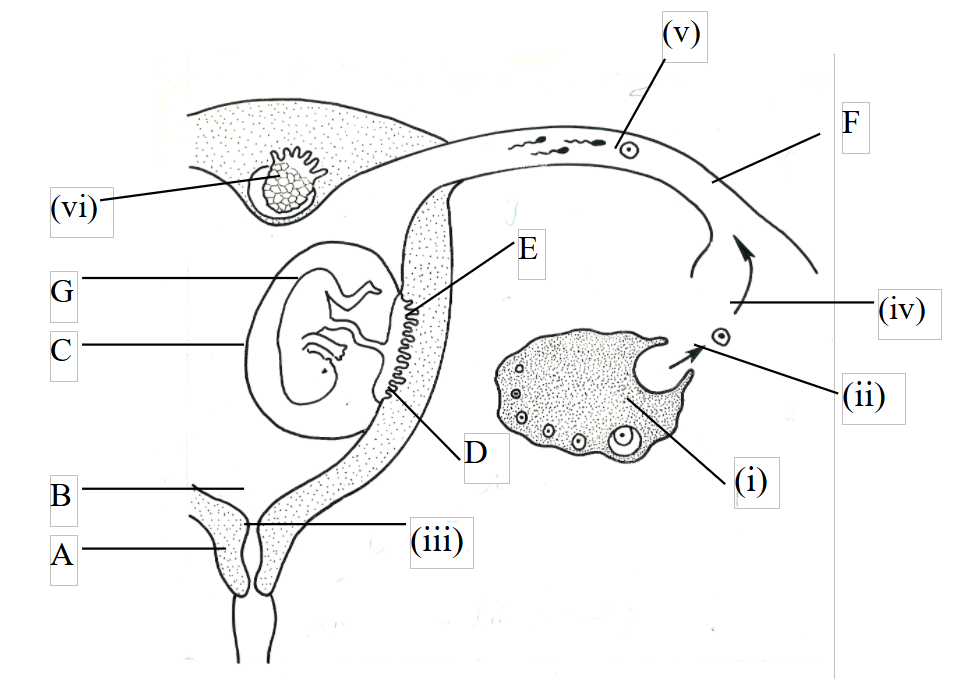
(A) vagina, (B) cervix, (C) amnion, (D) uterus, (E) placenta, (F) oviduct, (G) fetus.
(i) Ovum matures in ovary, (ii) ovum released from follicle, (iii) sperms deposited at top of vagina, (iv) ovum enters oviduct, (v) sperm fertilises ovum, (vi) embryo implants in lining of uterus.
7 Blood from the fetus circulates through the placenta.
(a) What substances pass (i) from the maternal to the fetal blood, (ii) from the fetal to the maternal blood?
(b) By what means is the fetal blood circulated through the placenta?
(a) (i) oxygen and digested food (glucose, amino acids) pass from maternal to fetal blood,
(ii) carbon dioxide and nitrogenous waste (urea) pass from fetal to maternal blood.
(b) The fetus’s own heart pumps blood through the fetal vessels in the placenta.
8 What is the function of the umbilical cord?
The umbilical cord contains blood vessels which convey blood between the fetus and the placenta.
9 What are the possible effects on the fetus if, during pregnancy, the mother (a) smokes,
(b) catches rubella?
(a) Smoking during pregnancy can lead to an underweight fetus.
(b) If a pregnant woman catches rubella in the first 4 months of pregnancy, the fetal ears, eyes and nervous system may be damaged.
10 Describe the events which lead to the formation of (a) identical twins, (b) fraternal twins.
(a) Identical twins are derived from the products of a single zygote which divides into two at an early stage of development.
(b) Fraternal twins result from the simultaneous fertilisation of two ova.
11 At an ante-natal clinic what can (a) blood tests, (b) urine tests reveal?
a) Blood tests can reveal the mother’s Rhesus blood group and show whether she is anaemic.
(b) Urine tests can confirm the pregnancy and show if she is diabetic. Later in pregnancy, the presence of proteins in the urine implies restricted circulation in the placenta.
12 Place the following events in the correct order for natural childbirth.
amniotic fluid expelled, placenta expelled from uterus, baby’s feet emerge from vagina, abdominal contractions begin, baby’ head emerges from vagina, amnion breaks, cervix dilates, contractions of the uterus begin .
Contractions of the uterus begin, amnion breaks, amniotic fluid escapes, cervix dilates, abdominal contractions begin, baby’s head emerges from vagina, baby’s feet emerge from vagina, placenta expelled from uterus.
Note: The amnion may break earlier or later, but prior to emergence.
13 (a) What are the advantages of human milk over cows’ milk for feeding babies?
(b) Apart from the composition of the milk, what are the other advantages of breast-feeding?
(a) Human milk is the correct composition for human babies and it contains antibodies to some diseases.
(b) The milk is free from bacteria and at the right temperature. Breast-feeding helps to establish a psychological bond between mother and baby.
14 Name (a) the male sex hormone and (b) the female sex hormone which help bring about the changes at puberty.
(a) testosterone, (b) oestrogen(s).
15 After ovulation (a) what structure replaces the Graafian follicle, (b) what hormone does it produce?
(a) After ovulation, the follicle is replaced by the corpus luteum.
(b) The corpus luteum produces the hormone progesterone.